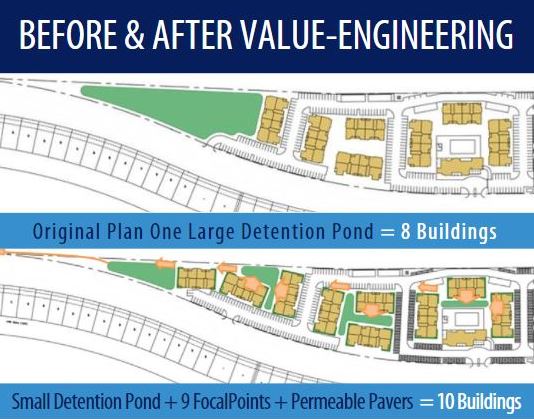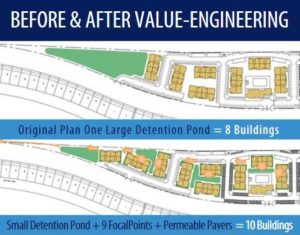![]()
Why LID / Green Stormwater Infrastructure?
In 2005, while most of the development and engineering community in Houston Texas had their doubts, Convergent Water Technologies set out to prove that Low Impact Development could do for the community what no other stormwater management approach could; reduce flood risk, improve stormwater quality and lower overall cost of development. Since then, we have traveled the country teaching others the discoveries and lesson’s we have learned along the way, pushing forward a new style of Low Impact Development that focuses on high performing, multifunctional systems as opposed to unproven prescriptive design. We call this Multifunctional Stormwater Design.
While developing Multifunctional Stormwater Design with our partners and early adopters, we used developers and municipalities as our guiding light, or North Star, in our pursuit, knowing that in order to get their full buy-in, we would need to understand what was most important to them. So, why would a developer or municipality ever want to use Multifunctional Stormwater Design?
- Lower Upfront Construction Cost
- Increased Lot Yield
- Lower Long-Term Maintenance Costs
- No Design / Construction Delays
While the rest of the country was focused on water quality, we were focused on water management. While the rest of the country focused on treating one inch of rainfall, we were pushing the limits and learning how to manage the largest storms. We believed that if we could make Multifunctional Stormwater Design work in a place like Houston Texas, we could make it work anywhere. Why?
- Clay Soils = Very Little Infiltration
- Shallow Outfalls = Many Roadside Ditches
- Intense Rains = 2016 Tax Day Flood 16 inches in 12 Hours
- Extended Rains = 2017 Hurricane Harvey 40”+ in 60 hours
- High Annual Average Rainfall = 54” Annually
- Flat Coastal Prairie
- Could there be a better place to prove LID Works?
Since 2005, the team at Convergent Water Technologies and it’s partners around the country have dedicated their work to both the big discoveries and the small, that have drastically improved the performance and reliability of Low Impact Development. Collectively, they have been compiled here on this site, so that you may take advantage of the knowledge that has come from our success as failures.
![]()
![]()
The Value of Our
Value-Engineering
In keeping with our history of seeking out innovative solutions to common stormwater problems that exceed regulatory requirements and lower total cost of compliance, we’ve identified and introduced to Texas a number of BMPs that can assist engineers in solving their project’s stormwater quality and stormwater quantity problems and drive down costs. Virtually all new projects, and most redevelopments, constructed today must account for the quantity and quality of the water leaving the site once construction is complete, and forever after. Compliance with these regulations is often confusing and it’s difficult to identify ideal Best Management Practices (BMPs) that will meet site constraints as well as budgetary goals.
The term value engineering often means you found a cheaper option, which many times equates to an inferior solution from the original engineered design. This is often a risky proposition as the contractor is looking to save or make money on a contract already rewarded and the designer is concerned with who assumes liability. At Construction EcoServices, we simply see this as cost cutting, because there is no true value in this transaction.
Our philosophy at Convergent has always been to lower total cost while raising overall compliance.
While we do have options in our repertoire that can cut costs, swapping one similar product for another is not what drives our business. Our mission is to be able to truly add value to the project through innovative water management strategies that do so in the form of decreasing stormwater volume necessary, improving water quality leaving the site, enhancing the aesthetics value of the site and doing so with the projects budget in mind.
Convergent brings value to value engineering.

Featured LID Innovation
FocalPoint Biofiltration System
While automation is not new, stormwater automation is only in its infancy. It’s no wonder Construction EcoServices, a leader in Stormwater Innovation has been involved in many of the first stormwater automation projects. From managing subsurface underground detention / rainwater harvesting systems through weather predictive technology to creating automated settling ponds for stormwater quality, Construction EcoServices is once again on the bleeding edge of stormwater management. The future of stormwater is automated, through controls, sensors and telemetry, we will soon change the way stormwater is managed. A move from passive control to active control is on the horizon.
![]()
![]()
![]()
LID CASE STUDY
Project Background
Queenston Manor Apartments sits on a 7.2 acre parcel of land located adjacent to a master planned community on Houston’s northwest side. When Academy Development originally planned the construction of an apartment complex on this site, the economic model required that nine apartment buildings be built in order to generate the required revenue stream. Operating under the premise that all of their detention had been accounted for offsite in the surrounding master planned development, the project came to a screeching halt when it was determined by the County that the volume presumably set aside was no longer available for use by the apartment site. The engineers at EHRA, Inc. rescued this project with Low Impact Development (LID) and the FocalPoint High Performance Modular Biofiltration System (HPMBS),
Why Use Low Impact Development?


FocalPoint High Performance Modular Biofiltration System (HPMBS)
The FocalPoint HPMBS is a combination of a high performance, open cell underdrain, a clog-proof bridging mesh, bridging stone, and a high performance biofiltration media that flows at a rate of over 100” per hour. What this unique combination of parts creates is a system that provides unsurpassed water quality and drainage characteristics. For the purpose of Queenston Manor Apartments, reliability was an important element in that all of the drainage areas are also common areas and courtyards. It was imperative that the system could be relied upon to drain as designed so that within 24 hours of a rain event, there would be no standing water. By placing the HPMBS at the lowest elevation in the four landscaped swale systems on site, we were able to give Queenston Manor a reliable drainage and water quality solution.
Quality Solutions
The Queenston Manor Apartments boast extraordinary amenities including a full service bar on site as well as an infinity pool. One of the most impressive and unique features of the site, however is the use of Low Impact Development practices throughout the property.
